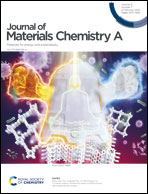Revealing the absence of carbon in aprotic Li–CO2 batteries: a mechanism study toward CO2 reduction under a pure CO2 environment†
Abstract
While attention is focused on Li–CO2 batteries due to their high energy density and ability to utilize carbon, their detailed cathodic reaction mechanism remains unclear. Thus far, the recognized reaction formula involves CO2 reduction with carbon as the reduced product (3CO2 + 4Li+ + 4e− → 2Li2CO3 + C, E° = 2.8 V vs. Li+/Li). However, evidence of carbon formation is seldom provided in previous studies. The potential of the potential-determining step (CO2 + e− → CO2−, E° = 1.1 V vs. Li+/Li) in the reaction is much lower than the common working potential (2.6 V). Furthermore, the calculated redox potential at 2.8 V itself is incorrect since the calculation includes chemical reaction(s) that does not involve electron transfer. These findings do not suggest that the proposed cell reaction is correct. Herein, we propose that the previously observed reaction is caused by O2 and H2O participating in the electrochemical reaction to give such a high working potential. The formation of Li2CO3 as the only discharge product can support our statement through examination by soft X-ray absorption spectroscopy. Moreover, we find that the reaction of sole CO2 reduction can only happen at a low potential of 1.1 V with a current density of 100 mA g−1. CO, rather than C, is found to be the discharge product. Thus, both O2 and H2O contamination should be considered when studying Li–CO2 batteries, and the discharge product should be characterized carefully to claim the reaction formula.



 Please wait while we load your content...
Please wait while we load your content...